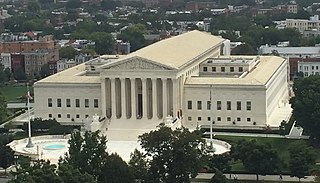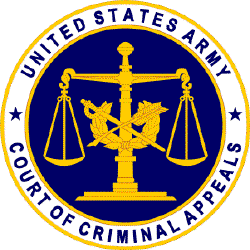
United States appellate procedure involves the rules and regulations for filing appeals in state courts and federal courts. The nature of an appeal can vary greatly depending on the type of case and the rules of the court in the jurisdiction where the case was prosecuted. There are many types of standard of review for appeals, such as de novo and abuse of discretion. However, most appeals begin when a party files a petition for review to a higher court for the purpose of overturning the lower court's decision.

An appellate court, commonly called a court of appeal(s), appeal court, court of second instance or second instance court, is any court of law that is empowered to hear a case upon appeal from a trial court or other lower tribunal. In much of the world, court systems are divided into at least three levels: the trial court, which initially hears cases and considers factual evidence and testimony relevant to the case; at least one intermediate appellate court; and a supreme court (or court of last resort) which primarily reviews the decisions of the intermediate courts, often on a discretionary basis. A particular court system's supreme court is its highest appellate court. Appellate courts nationwide can operate under varying rules.
In United States federal law, the Daubert standard is a rule of evidence regarding the admissibility of expert witness testimony. A party may raise a Daubert motion, a special motion in limine raised before or during trial, to exclude the presentation of unqualified evidence to the jury. The Daubert trilogy are the three United States Supreme Court cases that articulated the Daubert standard:
In United States law, a harmless error is a ruling by a trial judge that, although mistaken, does not meet the burden for a losing party to reverse the original decision of the trier of fact on appeal, or to warrant a new trial. Harmless error is easiest to understand in an evidentiary context. Evidentiary errors are subject to harmless error analysis, under Federal Rule of Evidence 103(a) The general burden when arguing that evidence was improperly excluded or included is to show that the proper ruling by the trial judge may have, on the balance of probabilities, resulted in the opposite determination of fact.
In law, the standard of review is the amount of deference given by one court in reviewing a decision of a lower court or tribunal. A low standard of review means that the decision under review will be varied or overturned if the reviewing court considers there is any error at all in the lower court's decision. A high standard of review means that deference is accorded to the decision under review, so that it will not be disturbed just because the reviewing court might have decided the matter differently; it will be varied only if the higher court considers the decision to have obvious error. The standard of review may be set by statute or precedent. In the United States, "standard of review" also has a separate meaning concerning the level of deference the judiciary gives to Congress when ruling on the constitutionality of legislation.
In law, a question of law, also known as a point of law, is a question that must be answered by applying relevant legal principles to the interpretation of the law. Such a question is distinct from a question of fact, which must be answered by reference to facts and evidence as well as inferences arising from those facts. Answers to questions of law are generally expressed in terms of broad legal principles. They can be applied to many situations rather than particular circumstances or facts. An answer to a question of law as applied to the specific facts of a case is often referred to as a conclusion of law.

The Oklahoma Court on the Judiciary is one of the two independent courts in the Oklahoma judiciary and has exclusive jurisdiction in adjudicating discipline and hearing cases involving the removal of a judge from office, excluding the Oklahoma Supreme Court, exercising judicial power under the Oklahoma Constitution.

In the United States military, the Army Court of Criminal Appeals (ACCA) is an appellate court that reviews certain court martial convictions of Army personnel.
An ultimate issue in criminal law is a legal issue at stake in the prosecution of a crime for which an expert witness is providing testimony.

R v W (D), [1991] 1 S.C.R. 742 is a leading decision of the Supreme Court of Canada on assessing guilt based on the credibility of witnesses in a criminal trial. More specifically, W.D. examines sexual assault cases and burdens of proof in evidence law.
United States v. Johnson, 327 U.S. 106 (1946), was a United States Supreme Court case.

R v Henry [2005] 3 S.C.R. 609 is a leading Supreme Court of Canada case on the protection against self-incrimination in section 13 of the Canadian Charter of Rights and Freedoms. The court ruled that the Crown may use the accused's previous voluntarily given testimony to incriminate or impeach credibility in a retrial if the accused again chooses to testify at said retrial. The court further held that no distinction should be drawn between the use of such evidence to incriminate the accused directly or to impeach their credibility. The Court partially restored this distinction in R. v. Nedelcu, 2012 SCC 59.
Peterson v Minister of Safety and Security is an important case in South African criminal law. For the appellant appeared J Whitehead SC, instructed by JL Martinson & Company, Cape Town; for the respondents, A Schippers SC and S O'Brien, instructed by the State Attorney, Cape Town.

Fish v. Kobach was a 2018 bench trial in the United States District Court for the District of Kansas in which five Kansas residents, the ACLU and the League of Women Voters contested the legality of the Documentary Proof of Citizenship (DPOC) requirement of the Kansas Secure and Fair Elections (SAFE) Act, which was enacted in 2011 and took effect in 2013.

M v R or M v The Queen is an Australian legal case decided in the High Court. It is an important authority in the field of criminal law, for the circumstances in which it is permissible for a jury's guilty verdict to be overturned by a judge. The case involved an appeal against criminal conviction by a father, against allegations of sexual assault and rape by his daughter. His appeal was allowed by majority.

Jones v Dunkel is a decision of the High Court of Australia, concerning inferences that may be drawn when a party fails to give evidence.

Dinsdale v R is an Australian legal case decided in the High Court.
Kimmelman v. Morrison, 477 U.S. 365 (1986), was a decision of the U.S. Supreme Court that clarified the relationship of the right to effective assistance of counsel under the Sixth Amendment to other constitutional rights in criminal procedure. In this case, evidence against the defendant was probably seized illegally, violating the Fourth Amendment, but he lost the chance to argue that point due to his lawyer's ineffectiveness. The prosecution argued that the defendant's attempt to make a Sixth Amendment argument via a habeas corpus petition was really a way to sneak his procedurally defaulted Fourth Amendment claim in through the back door. The Court unanimously disagreed, and held that the Fourth Amendment issue and the Sixth Amendment issue represented different constitutional values, and had different requirements for prevailing in court, and therefore were to be treated separately by rules of procedure. Therefore, the habeas corpus petition could go forward. In its opinion, the Court also gave guidance on how to apply its decisions in Stone v. Powell and Strickland v. Washington.
United States v. Throckmorton is an 1878 decision of the U.S. Supreme Court on civil procedure, specifically res judicata, in cases heard at equity. A unanimous Court affirmed an appeal of a decision by the District Court for California upholding a Mexican-era land claim, holding that collateral estoppel bars untimely motions to set aside the verdict where the purportedly fraudulent evidence has already been considered and a decision reached. In the opinion it distinguished between that kind of fraud, which it called intrinsic, and extrinsic fraud, in which deceptive actions exterior to the proceeding prevented a party, or potential party, to the action from becoming aware of the possibility they could vindicate their rights in court.

Pell v The Queen was a High Court of Australia decision that overturned the conviction of Cardinal George Pell for sexual offences against a child. On 22 June 2017, Victoria Police announced Pell's arrest for historical sexual assault charges on two choirboys at St Patrick's Cathedral in Melbourne. The allegations stemmed from Pell's time spent as Archbishop of Melbourne, and pertained to two anonymous victims referred to throughout the court process as victim A and victim B. B died before any allegation was reported to police. Pell was tried twice in the County Court of Victoria.








